Gene Editing Cattle for Enhancing Heat Tolerance: A Welfare Review of the “PRLR‑SLICK Cattle” Case

Pozzebon, M., Guldbrandtsen, B. & Sandøe, P. (2024)
Nanoethics. Springer Nature
Abstract
In March 2022 the US Food and Drug Administration (FDA) published a risk assessment of a recent animal gene editing proposal submitted by Acceligen™. The proposal concerned the possibility of changing the cattle genome to obtain a slicker, shorter hair coat. Using CRISPR-Cas9 it was possible to introduce an intentional genomic alteration (IGA) to the prolactin receptor gene (PRLR), thereby producing PRLR-SLICK cattle. The goal was to diminish heat stress in the cattle by enhancing their heat-tolerance. With regard to unintended alterations (i.e., off-target effects), the FDA stated that the IGA posed a low, but still present, risk to animal safety. The aim of this article is to present some initial insights into the welfare issues raised by PRLR-SLICK cattle by addressing the question: Do SLICK cattle have better welfare than non-SLICK cattle when exposed to heat stress? Two potential welfare concerns are examined. The first is pleiotropy, an issue that arises when one gene affects multiple traits. Given the pleiotropic nature of prolactin, it has been suggested that the IGA for SLICK cattle may also affect their hepatic and other functions. The second concern relates not primarily to direct effects on cattle health, but rather to the indirect risk that this more heat-tolerant animal would just be used in the livestock sector under farming conditions that are such that the net welfare improvement would be non-existent.
Gene Editing Cattle for Enhancing Heat Tolerance: A Welfare Review of the “PRLR‑SLICK Cattle” Case (URL)
